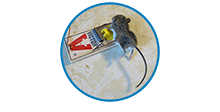Baltimore Wildlife Pest Control - 443-743-3057

Wildlife Trapping
When it's necessary to remove animals, we focus on humane and effective trapping and relocation.

Home Repairs
A critical step - the identification and repair of any and all wildlife entry points into the home.

Animals in Attic
We specialize in the removal of animals in the attic - squirrels, raccoons, rats, mice, bats, and more.

No Poisons!
We never use poisons in any part of our wildlife control, including rodent control. Poisons don't work!
We are Baltimore Wildlife, and we solve conflicts between people and wild animals. From squirrels in your attic, to raccoons in your trash, to bats, rats, birds, and snakes, we do it all. We specialize in safe and effective solutions to Maryland critter problems. We service the greater Baltimore region, and we offer fast service - we can usually schedule a same-day appointment. Give us a call at 443-743-3057 any time, 24/7, and we will discuss your unique wild animal problem, and give you a free price quote over the phone. We're ready to take your call now!
Our service range: We service Anne Arundel County, Baltimore County, Carroll County, Harford County, Howard County, Queen Anne's County, and more. We also service Columbia, Towson, Aberdeen, Annapolis, Bel Air, Catonsville, Dundalk, Ellicott, Glen Burnie, Havre de Grace, Joppatowne, Owings Mills, Westminster, and more.
Baltimore Wildlife Education: Do Raccoons Live In Trees or Sleep In Trees?
Raccoons are very adaptable animals that can live in many parts of the United States. They seem equally at home in wilderness areas as they do in large cities. But their preferred habitat is in a heavily wooded area that has good water sources, such as creeks, a lake, or a river, and plenty of vegetation. They like a mixture of hardwood and evergreen trees in all stages of growth. The water sources provide them with much of their food, such as fish, crayfish, snails, turtles, and frogs. Living in wooded areas also provides the other things that raccoons like to eat, such as berries, acorns, nuts, seeds, and insects.

Living in Trees
Raccoons don’t live in trees as we think of animals such as koalas that spend a good deal of their lives in the trees. However, the raccoon likes to find a hollow tree or fallen log in which to make a den. They will also climb a tree very rapidly to escape a predator, such as a coonhound that is chasing it. Raccoons like to eat bird eggs and baby birds, also, which gives them another reason to climb a tree. Raccoon “nests” and roosts have been found in trees, particularly in the large forks in tree limbs.
Sleeping in Trees
Raccoons have been observed sleeping draped over tree limbs. They will curl up in the fork of large tree limbs. They also like to find protected places to sleep such as underground burrows and dens, hollow logs, barns, sheds, in abandoned cars, rock clefts, brush piles, attics, crawl spaces, underneath porches, or any place they can get into and feel safe.
Urban Living
City raccoons will try to find similar living conditions in cities as they have in rural areas, if possible. Parks with trees and ponds are nicely suited for the city-dwelling raccoon. Private yards with trees are equally attractive to raccoons, as the trees often offer access to house attics where they like to make their home. Trees also afford an escape route when being chased by the family dog. Human homes also are the source of food for city raccoons who enjoy garden produce, grapes, berries, and the insects that inhabit the grass and shrubs of many yards. Raccoons will eat dog or cat food, too, sometimes arguing over it with the rightful owner, but sometimes eating peacefully side by side.
Raccoons are very adaptable animals that can live in many parts of the United States. They seem equally at home in wilderness areas as they do in large cities. But their preferred habitat is in a heavily wooded area that has good water sources, such as creeks, a lake, or a river, and plenty of vegetation. They like a mixture of hardwood and evergreen trees in all stages of growth. The water sources provide them with much of their food, such as fish, crayfish, snails, turtles, and frogs. Living in wooded areas also provides the other things that raccoons like to eat, such as berries, acorns, nuts, seeds, and insects.
Living in Trees
Raccoons don’t live in trees as we think of animals such as koalas that spend a good deal of their lives in the trees. However, the raccoon likes to find a hollow tree or fallen log in which to make a den. They will also climb a tree very rapidly to escape a predator, such as a coonhound that is chasing it. Raccoons like to eat bird eggs and baby birds, also, which gives them another reason to climb a tree. Raccoon “nests” and roosts have been found in trees, particularly in the large forks in tree limbs.
Sleeping in Trees
Raccoons have been observed sleeping draped over tree limbs. They will curl up in the fork of large tree limbs. They also like to find protected places to sleep such as underground burrows and dens, hollow logs, barns, sheds, in abandoned cars, rock clefts, brush piles, attics, crawl spaces, underneath porches, or any place they can get into and feel safe.
Urban Living
City raccoons will try to find similar living conditions in cities as they have in rural areas, if possible. Parks with trees and ponds are nicely suited for the city-dwelling raccoon. Private yards with trees are equally attractive to raccoons, as the trees often offer access to house attics where they like to make their home. Trees also afford an escape route when being chased by the family dog. Human homes also are the source of food for city raccoons who enjoy garden produce, grapes, berries, and the insects that inhabit the grass and shrubs of many yards. Raccoons will eat dog or cat food, too, sometimes arguing over it with the rightful owner, but sometimes eating peacefully side by side.
Previous Education Articles
Where do Baltimore snakes live? Do more snakes live in urban areas, or wild areas?
What should I do with a Baltimore house mouse after I catch it?
Damage That Baltimore Chipmunks Can Cause To Your Property
Can repellents get Baltimore flying squirrels out of the attic reliably?


